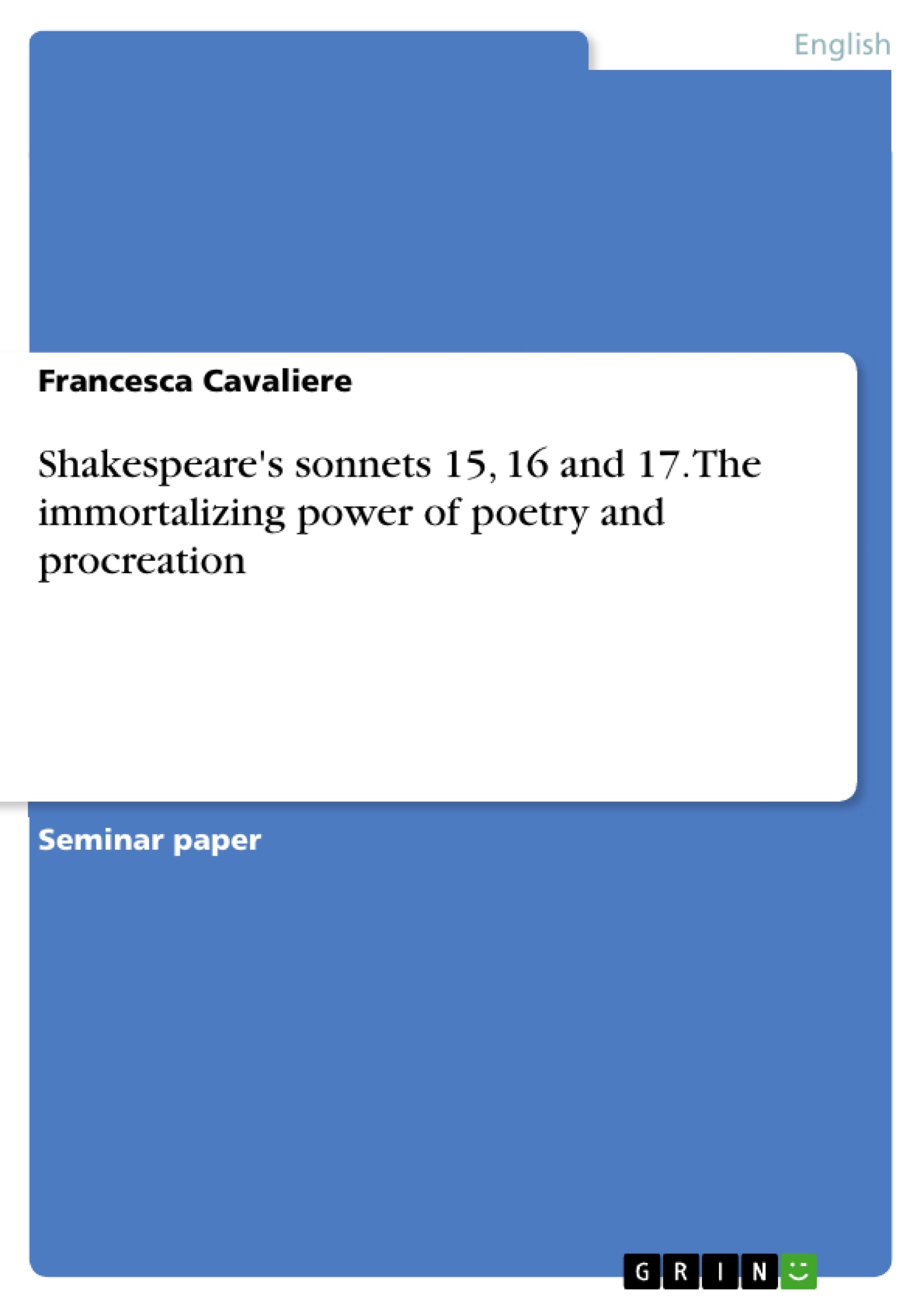Shakespeare’s Sonnets 15, 16 and 17 belong to the group of procreation sonnets, running from 1 to 17 in the collection of “Shakespeare’s sonnets”. In this sonnet sequence the speaker urges the young man to marry and to beget children in order to preserve his beauty and achieve everlasting life. The power of the young man to perpetuate himself by biological generation is confronted to poetry as another method to reach immortality (Cheney, 126/128).
In sonnet 15 the speaker depicts the mortality of all living creatures and points out that the young man, too, will fall victim to the transitory nature of things. Nevertheless in the couplet he “sells” himself as a poet whose verse would give his young patron immortality. This idea is immediately dismissed in the following sonnet 16 where he urges the young man not to rely on his sonnets alone and recommends biological procreation as the superior mean to represent the young man’s beauty adequately. In sonnet 17 the persona finally describes how procreation and poetry can work together to reach double immortality. Here again the speaker points out that his poetry is of far lesser worth to give immortality to the young man’s beauty than his own creation of progeny would be.
Dispraising his own works in favour of the begetting of children is very contrary to what one would expect from a poet. Furthermore, it remains open to question how the speaker’s understatement of his own art and his convincingly depiction of the omnipresence of mortality go together with his courageous promise to immortalize the young man in verse. It will therefore be interesting to find out which techniques the speaker applies to make the young man procreate and what this might reveal about the true nature of his interest to immortalize the young man. By responding to these questions, one can only come to the conclusion that the speaker has other reasons than those of personal affection for wishing to keep the young man’s beauty in being.
After having presented some formal aspects of the sonnets, the first main part of the paper will be concerned with the question of how mortality and passage of beauty are depicted in the sonnets. Special emphasis will be put on the concepts of vertex and war contributing to make the young man realize the instability of his beauty and showing him methods to preserve it.
The second main part of the paper will deal with the speaker’s comparison of his poetry to the supposed superior power of procreation.
Table of Contents
- Introduction
- Form and Structure
- The depiction of mortality and passage of beauty
- Concept of vertex and helplessness
- War against time
- Modesty vs. magalomania
- Fruitlessness of verse
- The unreliability of poetic reproduction
Objectives and Key Themes
This paper explores Shakespeare's Sonnets 15, 16, and 17, which belong to the procreation sonnets, focusing on the speaker's urge for the young man to marry and procreate to preserve his beauty and achieve immortality. It examines the tension between the speaker's praise of biological generation and his own poetic ambitions to attain immortality through verse.
- The depiction of mortality and passage of beauty in the sonnets, highlighting the concepts of vertex and helplessness.
- The speaker's comparison of poetry to the superior power of procreation, analyzing the fruitlessness and unreliability of poetic reproduction.
- The speaker's motivations for encouraging the young man to procreate, exploring the complex dynamics between personal affection, artistic ambition, and social expectations.
- The formal structure of the sonnets and their use of language and imagery to convey the themes of mortality, beauty, and immortality.
- The speaker's complex relationship with the young man, exploring the nature of their interactions and the speaker's underlying intentions.
Chapter Summaries
The introduction examines the context of Shakespeare's procreation sonnets, particularly Sonnets 15, 16, and 17, highlighting the speaker's argument for procreation as a means of achieving immortality. The chapter then discusses the speaker's contrasting claims about the power of poetry and the complexities of his motivations.
The second chapter analyzes the formal structure of the sonnets, examining their rhyme scheme, syntax, and meter. It explores the relationship between form and meaning in the sonnets and how their structure contributes to the overall argument.
The third chapter focuses on the depiction of mortality and the passage of beauty in Sonnets 15 and 16. It delves into the concept of vertex and the speaker's use of language and imagery to convey the temporal instability of beauty and the importance of procreation.
Keywords
Shakespeare's Sonnets, Procreation Sonnets, Mortality, Beauty, Immortality, Vertex, Procreation, Poetry, Fruitlessness, Unreliability, Poetic Reproduction, Formal Structure, Rhyme Scheme, Syntax, Meter, Language, Imagery, Motivations, Social Expectations.
- Citar trabajo
- Francesca Cavaliere (Autor), 2008, Shakespeare's sonnets 15, 16 and 17. The immortalizing power of poetry and procreation, Múnich, GRIN Verlag, https://www.grin.com/document/315231



